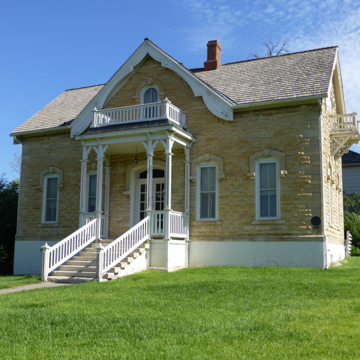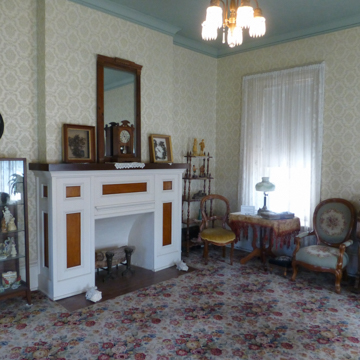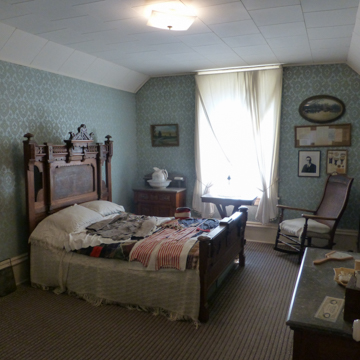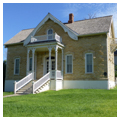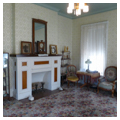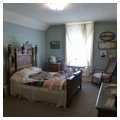You are here
Mueller-Schmidt House
The Mueller-Schmidt house is one of the oldest remaining residences in Dodge City. It is a rare example of a stone house in an area where stone is less easily accessible than in other parts of Kansas.
The house was built for John Mueller, a boot maker who had emigrated from southern Germany by way of St. Louis. Mueller arrived in Dodge City in 1875, only three years after the town was staked out, and one year before Dodge City became the trailhead of the Chisholm Trail, on which cattle driven from Texas were slaughtered and the meat was transferred to railroad cars for distribution to eastern markets. Dodge City served as the trailhead until 1886. During this time, Dodge City was the epitome of the “wild west,” where cowboys and outlaws could procure much needed recreation and supplies.
Mueller’s business thrived in this environment, allowing him to buy into a saloon and three ranches. By 1879, he began construction of a house for his family on a hillside overlooking downtown Dodge City. He enlisted the help of two fellow German immigrants, stonemason William Hessman and carpenter William Strubel. Hessman quarried carefully matched stone from the Sawlog Creek area northeast of Dodge City. The evenly coursed rough stone of the walls contrasted nicely with the smooth corner quoins and window surrounds. Strubel’s skills were most clearly showcased in the curving cantilevered stair in the central hallway. The simple, rectilinear structure has three levels, each of which has two rooms flanking a central stairway. The raised basement accommodates the original kitchen and a utility room. A parlor and a large bedroom are located on the main floor, and two smaller bedrooms are tucked under the eaves of the top floor. When it was completed in 1881, the Dodge City Times called it the finest residence in the West.
In 1886, Mueller’s fortunes began to turn. The expansion of the railroads and the redefinition of the quarantine line for Texas cattle, which sometimes carried ticks responsible for the spread of splenic fever, pushed the trailhead for the Chisholm Trail westward from Dodge City. The business climate for Mueller and other entrepreneurs changed dramatically with the relocation of the trailhead. Sadly, in the same year, a blizzard took the lives of many of Mueller’s cattle. Then fires on Front Street claimed Mueller’s boot-making business. In 1890, he decided to return to St. Louis. Mueller sold his house to German immigrant Adam Schmidt, a local blacksmith.
The house was owned by the Schmidt family for seventy-five years. Schmidt died in 1911 and his wife Elizabeth resided in the house until her death in 1938. The two unmarried Schmidt children, Heinrich and Elma, continued to live there following their mother’s death. They preserved the house, making changes as necessary to make it more livable. They added a bathroom into the hallway of the upper floor, a kitchen to the back of the house on the main level, and a garage behind the new kitchen.
In 1965, Elma sold the house and its original furnishings to Ford County. It was opened for public tours by the Ford County Historical Society, which continues to care for the building. Docents from the Historical Society use the house to illustrate early life in Dodge City.
NOTE: This entry was originally published in David Sachs and George Ehrlich, Guide to Kansas Architecture (Lawrence: University Press of Kansas, 1996). © 1996 by the University Press of Kansas.
References
Hall, Charles, and Richard Pankratz, “Meuller-Schmidt House,” Ford County, Kansas. National Register of Historic Places Inventory–Nomination Form, 1972. National Park Service, U.S. Department of the Interior, Washington, D.C.
Writing Credits
If SAH Archipedia has been useful to you, please consider supporting it.
SAH Archipedia tells the story of the United States through its buildings, landscapes, and cities. This freely available resource empowers the public with authoritative knowledge that deepens their understanding and appreciation of the built environment. But the Society of Architectural Historians, which created SAH Archipedia with University of Virginia Press, needs your support to maintain the high-caliber research, writing, photography, cartography, editing, design, and programming that make SAH Archipedia a trusted online resource available to all who value the history of place, heritage tourism, and learning.

